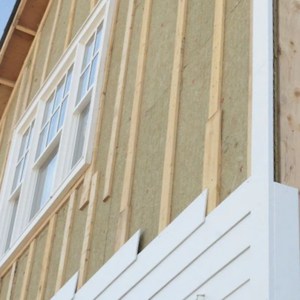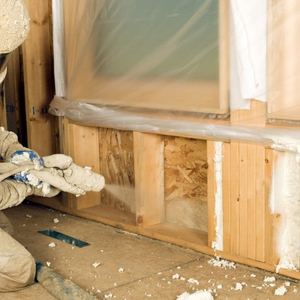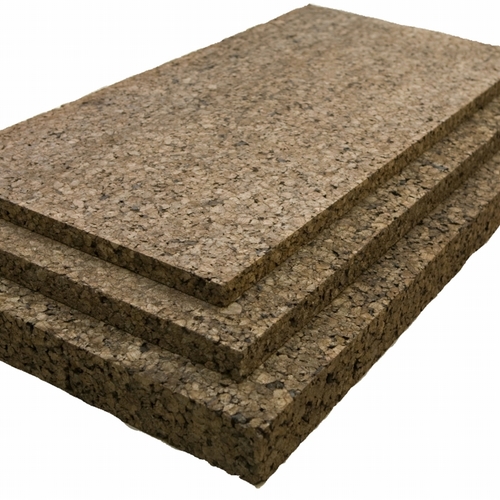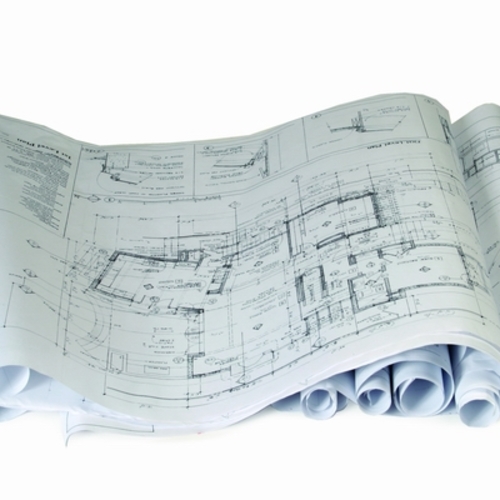Image Credit: Ecovative Design
Image Credit: Ecovative Design Mushroom insulation grown in place. This is what it looks like after the mycelium has done done its thing.
Image Credit: Ecovative Design Mushroom insulation in board form. Ecovative Design has plans to use their process to make green replacements for plastic foam insulation, structural insulated panels, acoustical tiles, medium density fiberboard (MDF), particle board, adhesive, and engineered wood.
Image Credit: Ecovative Design
Rather than blowing agents, this insulation uses growing agents. It’s natural. It’s made with agricultural waste and fungi. You can grow it in place. No hydrocarbons are involved, and it yields little to no toxic waste. Compared to most other insulation materials, it takes little energy to make the stuff (low embodied energy). Indoor air quality is likely to be better, too.
Wow! If you’re looking for a super green insulation, mushroom insulation could be for you… if you can wait a bit longer.
How mushroom materials science got its start
I first heard about this a while back when I saw a TED Talk by Eben Bayer, Are mushrooms the new plastic? While studying engineering at Rensselaer Polytechnic Institute, Bayer and his classmate, Gavin McIntyre, came up with the idea of using mycelium, the white vegetative strands of fungus you find under logs, to grow materials that could replace plastics.
They’ve gotten a lot of great media coverage, and I recently read a really nice article in the New Yorker about them. According to that piece, the two young engineers worked on developing their idea in their senior year at RPI and then took it full time into a business incubator upon graduation. The challenges were numerous, as they experimented with different varieties of mycelium and substrates. But, along with starting a few fires in their lab, they persisted and promoted and had some good help from advisers who saw the potential of their idea.
At first they used grants and the winnings from competitions to finance the company. One of those competitions was the Postcode Lottery Green Challenge, which gives a huge chunk of money (~$700,000) to the business with the best idea for reducing CO2 emissions. They entered in 2008 and won.
Mushroom insulation sprouts in New York
They decided that using their materials as a replacement for packaging was the most marketable direction to go, so mushroom insulation got put on hold for a while. They’ve since picked it back up, and their focus has been on building tiny houses and growing the insulation in the assemblies. They’ve got a nice blog about the project, and it’s called — you guessed it — Mushroom Tiny House. One of the things you’ll find there is a nice little video explaining how they make insulation from mushrooms.
I recently spoke with Sam Harrington of Ecovative Design, the company started by Bayer and McIntyre, and got the scoop on where they’re going with this. The plan at first is to grow insulation that can be used in board form and as structural insulated panels (SIPs). The mushroom tiny house is basically a grown-in-place SIP.
Harrington said they’re benchmarking their product against extruded polystyrene (XPS). The advantages are that it uses natural materials, doesn’t have the global warming issues associated with the blowing agents in foam insulation, and has much lower embodied energy. The main drawback is the lower R-value. XPS is about 5 per inch, and mushroom insulation ranges from 1.8 to 4 per inch, with the typical material coming in at about 3 per inch. That means that your walls are going to have to be thicker with mushroom insulation.
Mushroom insulation and indoor air quality
Their longer-term plans include using it to replace as many environmentally-harmful materials as possible: plastic foam, acoustical tiles, medium density fiberboard (MDF), particle board, adhesive, and engineered wood. One advantage of their materials is that the mycelium is their adhesive, so they don’t have to use the stuff with nasty volatile organic compounds (VOCs). That means better indoor air quality.
But wait, I hear you asking, what about the IAQ problems of having fungus and spores and who knows what from the oat hulls and wheat chaff substrate? Ah, but there are no spores. They’re using mycelium only. And although they call it mushroom insulation, you’ll see no mushrooms sprouting from the walls. The substrates used as the filler material that the mycelium feeds on and weaves together are sterilized to prevent other organisms from growing. Then, once the mushroom insulation has finished growing, they hit it with steam to stop the growth.
Get ready for mushroom insulation
None of the mushroom insulation products is ready for market yet. If you’re an early adopter, Ecovative Design is taking pre-orders. (According to their blog, the cost is about $0.66 per board foot.) To get shipments of mushroom board insulation, SIPs, or the other materials they’re working on, you’ll need to wait a while longer.
When their building products enter the market, I hope they can scale it up so that the cost is competitive with the other materials out there. It’s also going to be important for them to do enough R&D to reduce the number and severity of problems that new products so often have.
Yeah, it’s still fairly early in the development of mushroom insulation, but I’m excited to see this material getting ready to enter the building products market. When it does, it may well be the greenest insulation available.
Allison Bailes of Decatur, Georgia, is a speaker, writer, energy consultant, RESNET-certified trainer, and the author of the Energy Vanguard Blog. You can follow him on Twitter at @EnergyVanguard.
Weekly Newsletter
Get building science and energy efficiency advice, plus special offers, in your inbox.
















2 Comments
Given the speed of biological processes...
...I'm having a hard time figuring out how they'll be able to scale this up to high volume production.
The feedstocks are bulky (requires storage real estate), and the process itself is probably measured in days or weeks (which takes a lot of processing real-estate to do in high volume.) The material costs are low, and it's pretty cool stuff, but the manufacturing space issue seems really daunting to this casual observer.
I'm also wondering if it would be possible to manufacture it in large blocks, then sawed to reasonably tight dimensional tolerances, or if there are any issues with dimensional changes over decade timescales (as we've seen with polystyrene foam insulation)??
Or mayhaps the "manufactured in place" model of the Mushroom Tiny House is expected to become scalable to full-sized multi story buildings or modules? The MTH has a lot of thermal bridging from framing elements, but can the insulation itself become reliably structural, to minimize the thermal bridging problem? At ~R3 nominal per inch, it would take something like 8+ inches to hit US climate zone 5 code-min performance with the thermal bridging included, but 5-6" if the thermal bridging can be reduced to about where it is with current SIP technology.
Moisture performance is another big question mark- the MTH was clad in Grace Ice & Water, putting a true vapor barrier on the EXTERIOR of the building, which may have some serious long term issues in the VT location where it was made.
not seeing it either
A great product idea - although I would like to see the whole life cycle cost and trade offs, nothing is 'free' - I just don't see a large scale building potential.
Probably the best hope is for packaging and protecting building materials in transit, and then just mulching this packaging into the landscape on site (or feeding it to the local stray dog lol). Their test of protecting an ocean buoy and then dropping it in ocean with mushroom protection to dissolve is a perfect route for this stuff.
That and growing the medium in intricate objects for which spray foam is damaging. Maybe grow this stuff in the gap in between windows and building structure.
Sadly most oil based products use 'leftovers' of oil production, and as long as we are sucking down the gas and diesel, oil based resins will be near impossible to beat on price, just in the scope of the scale of the operations.
Log in or create an account to post a comment.
Sign up Log in